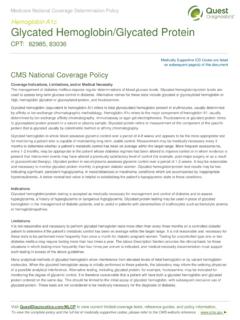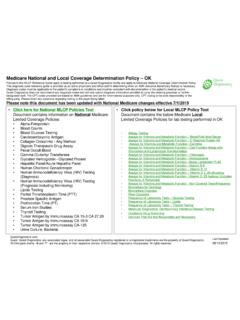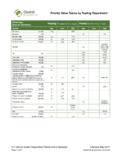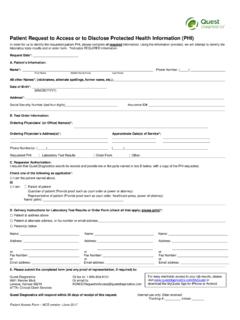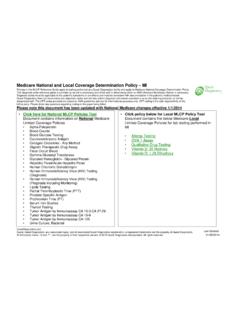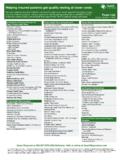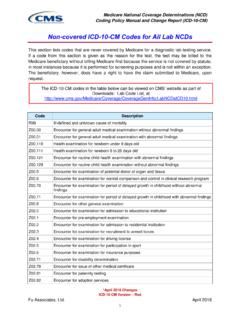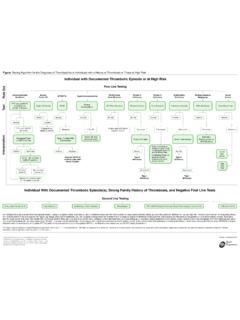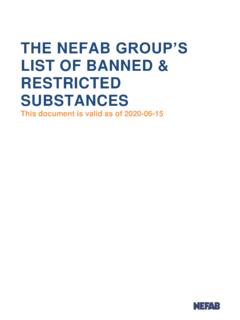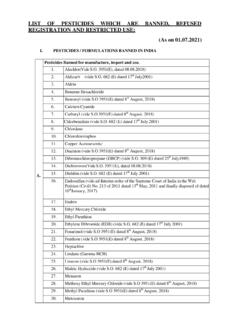Transcription of Medicare Local Coverage Determination Policy HbA1c
1 Medicare Local Coverage Determination PolicyCPT:CMS Policy for Alabama, Georgia, North Carolina, South Carolina, Tennessee, Virginia, and West VirginiaLocal policies are determined by the performing test location. This is determined by the state in which your performing laboratory resides and where your testing is commonly view current limited Coverage tests, reference guides, and Policy view the complete Policy and the full list of medically supportive codes, please refer to the CMS website referenceMedically Supportive ICD Codes are listed on subsequent page(s) of this (HEMOGLOBIN; GLYCOSYLATED A1C)HbA1cCoverage Indications, Limitations, and/or Medical NecessityHemoglobin A1c ( HbA1c ) refers to the major component of hemoglobin A1,usually determined by ion-exchange affinity chromatography, immunoassay or agar gel electrophoresis.
2 HbA1cassesses glycemic control over a period of 4-8 weeks and appears to be the more appropriate test for monitoring a patient who is capable of maintaininglong-term, stable control. Measurement may be medically necessary every 3 months to determine whether a patient's metabolic control has been, on average, within the target range. More frequent assessments, every 1-2 months, may be appropriate in the patient whose diabetes regimen has been altered to improve control or in whom evidence is present that intercurrentevents may have altered a previously satisfactory level of control (for example, post-major surgery, or as a result of glucocorticoid therapy). HbA1c is widely accepted as medically necessary for the management and control of of the HbA1c test at least two times a year in patients who are meeting treatment goals and who have stable glycemic control is supported by theAmerican Diabetes Association Standards of Medical Care in Diabetes -2016(ADA Standards)1.
3 For beneficiaries with stable glycemic control (defined as two consecutive HbA1c results meeting the treatment goals) performing the HbA1c test at least two times a year may be considered reasonable and necessary. The ADA framework for considering treatment goals recognizes that patient characteristics/health status are important factors when considering glycemic eligible for the Medicare home health benefit, for example, often have multiple coexisting chronic illnesses that would support a higher target goal for the HbA1c ( , < ) in order to avoid adverse events ( , hypoglycemia-related emergency department visits and acute inpatient hospitalization).It is also valuable to assess hyperglycemia, a history of hyperglycemia or dangerous hypoglycemia. It is not considered reasonable and necessary to perform HbA1c tests more often than once every three months on a controlled diabetic patient to determine whether the patient's metabolic control has been, on average, within the target range.
4 It is not considered reasonable and necessary for these tests to be performed more frequently than once a month for diabetic pregnant for uncontrolled type one or two diabetes mellitus(or other causes of severe hyper or hypoglycemia)may require testing more than four times a year. Palmetto GBA will allow one additional HbA1c test every three months for a total of 8 tests per year in patients with uncontrolled blood glucose levels. Additional tests beyond that frequency may be reimbursed on appeal with appropriate documentation of medical may be inaccurate in certain situations including anemia, transfusions, hemoglobinopathiesand conditions of rapid red cell turnover. Other tests to assess diabetes, including glucose, glycated protein, or fructosaminelevels, may be used and are described in the Lab National Coverage Determination (NCD for Glycated Hemoglobin / Glycated Protein).
5 This NCD lists the ICD-10 codesfor HbA1c for frequencies up to once every three months. The ICD-10-CM codes for test frequencies exceedingonce every3 monthsare listed to one additional test per 3 monthperiod for Diabetes Mellitus out of control (Group 1). to one monthly test for pregnant Type I diabetic patients (Group 3). CPT:The ICD10 codes listed below are the top diagnosis codes currently utilized by ordering physicians for the limited Coverage testhighlighted above that are also listed as medically supportive under Medicare s limited Coverage Policy . If you are ordering this test for diagnostic reasons that are not covered under Medicare Policy , an Advance Beneficiary Notice form is required. *Note Bolded diagnoses below have the highest utilizationMedicare Local Coverage Determination PolicyCMS Policy for Alabama, Georgia, North Carolina, South Carolina, Tennessee, Virginia, and West VirginiaLocal policies are determined by the performing test location.
6 This is determined by the state in which your performing laboratory resides and where your testing is commonly : This diagnosis code reference guide is provided as an aid to physicians and office staff in determining when an ABN (Advance Beneficiary Notice) is necessary. Diagnosis codes must be applicable to the patient s symptoms or conditions and must be consistent with documentation in the patient s medical record. quest diagnostics does not recommend any diagnosis codes and will only submit diagnosis informationprovided to us by the ordering physician or his/her designated staff. The CPT codes provided are based on AMA guidelines and are for informational purposes only. CPT coding is the sole responsibility of the billing party. Please direct any questions regarding coding to the payer being updated:Visit view current limited Coverage tests, reference guides, and Policy view the complete Policy and the full list of medically supportive codes, please refer to the CMS website reference , quest diagnostics , any associated logos, and all associated quest diagnostics registered or unregistered trademarks are the property of quest diagnostics .
7 All third-party marks and are the property of their respective owners. 2016 quest diagnostics Incorporated. All rights is a frequency associated with this test. Please refer to the Limitations or Utilization Guidelines section on previous page(s). Group 1 ICD-10 codes for performing tests at frequencies more than every 3 months. The following codes indicate or imply a condition of hyperglycemia and may be billed alone on the claim. Type 2 diabetes mellitus with diabetic chronic kidney 2 diabetes mellitus with 2 diabetes mellitus without complicationsGroup 2 The following codes do not, in and of themselves, indicate uncontrolled diabetes and must be used in conjunction with a Group 1 code that indicates a current state of uncontrolled diabetes (hyperglycemia). Secondary (Dual) 2 diabetes mellitus with diabetic 2 diabetes mellitus with unspecified diabetic retinopathy without macular 2 diabetes mellitus with diabetic neuropathy, 2 diabetes mellitus with diabetic peripheral angiopathy without 2 diabetes mellitus with other specified complicationGroup 3 ICD-10 codes related to pregnancy and can be covered no more frequently than once per month.
8 Type 2 diabetes mellitus, in pregnancy, unspecified 83036 (HEMOGLOBIN; GLYCOSYLATED A1C)5/27/22
